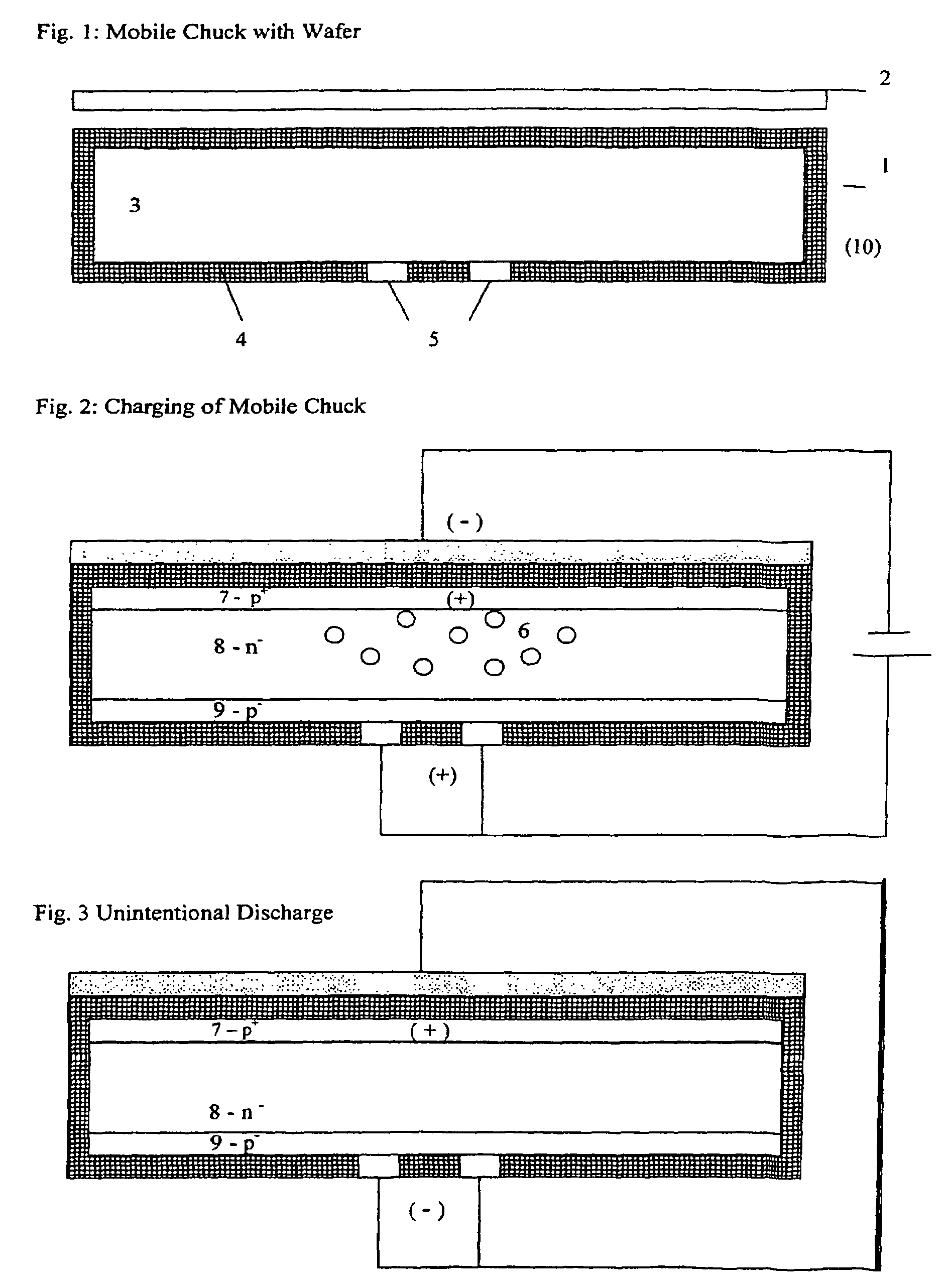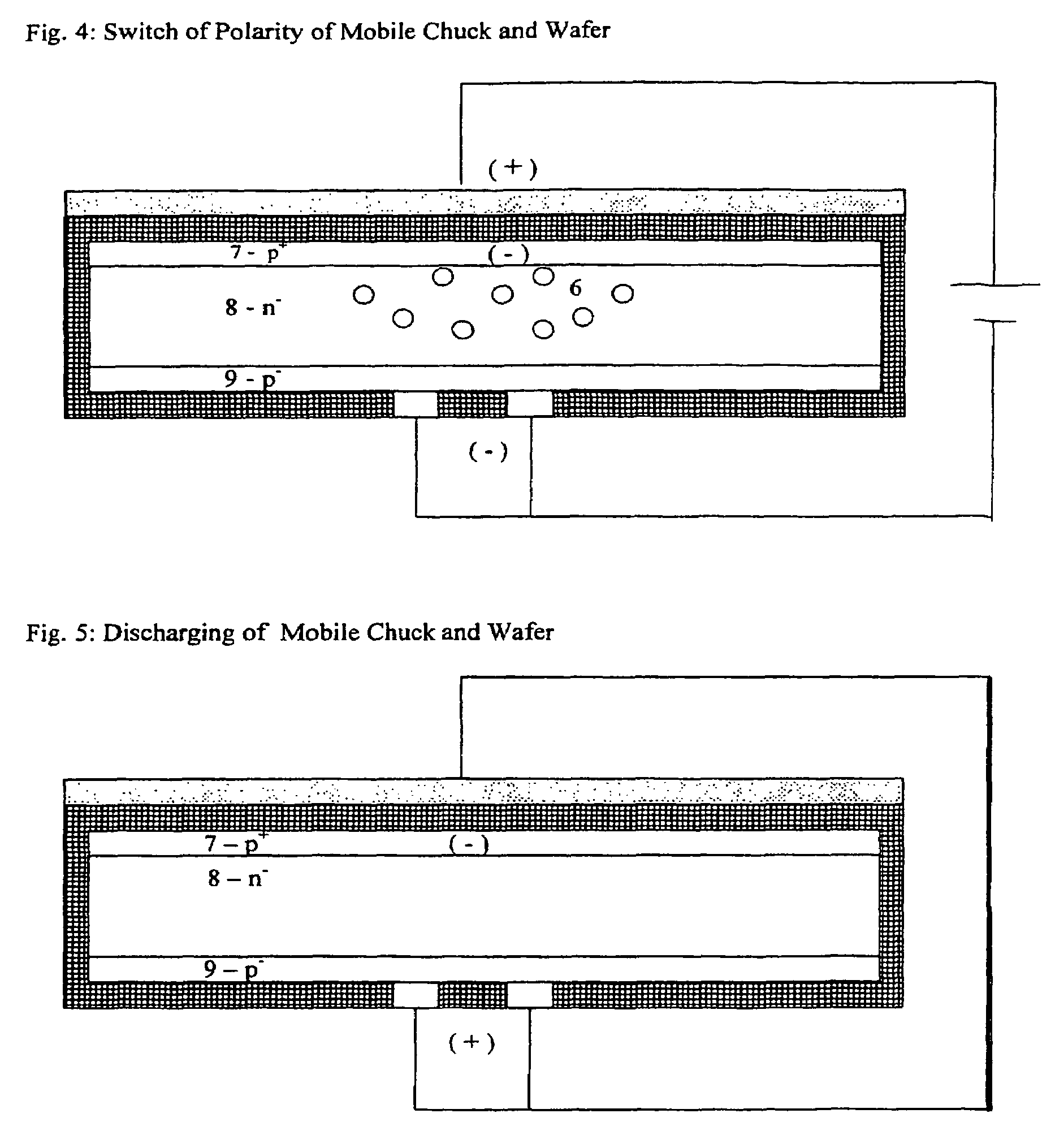Mobile, transportable, electrostatic chuck for wafers made of semiconductor material
a technology of electrostatic chucks and semiconductor materials, which is applied in the direction of electrostatic charges, capacitors, weapons, etc., can solve the problems of long time-consuming, inconvenient transportation, and inability to conduct diodes reverse biased, so as to reduce the likeliness of diodes, avoid the effect of conductivity and high breakdown voltag
- Summary
- Abstract
- Description
- Claims
- Application Information
AI Technical Summary
Benefits of technology
Problems solved by technology
Method used
Image
Examples
first embodiment
[0022]The first embodiment describes a capacitor structure of a unipolar Mobile Chuck (1) with clamped wafer (2), as shown in FIG. 1. The Mobile Chuck (1) is build up from a double side polished silicon wafer as semiconductor material (3), a 3.5 μm thick dielectric layer (4) from silicon dioxide and 100 nm silicon nitride with the opened contact holes (5) on the backside. The contact holes (5) are reaching through to the semiconductor material (3) and are used to contact the Mobile Chuck (1) during charging and discharging. The wafer (2) to be clamped, works as the first electrode and the semiconductor—material (3) acts as the second electrode of the capacitor structure. Both electrodes are separated electrically with the dielectric insulating layer (4).
embodiment 350
[0023]The application of a clamping voltage of 300 V, as described in FIG. 2, generates an electric field between the negative charged—or grounded—wafer (2) and the positive charged semiconductor material (3). The wafer (2) attracts the Mobile Chuck (1) and is now electro-statically clamped (activated). In accordance with the invention, within the substrate material (3) there are differently doped (p- and n-type) semiconductor layers (7,8,9) arranged. The substrate material (3) is a silicon wafer itself, phosphorus doped, n-type with a specific resistance of 10-20 Ohm*cm. This n−-type bulk region (8) has the lowest doping level. That's why the depletion region is extending deep into the low doped bulk region. The break trough voltage of the pn-junction is designed to avoid Punch-Through-effects, avalanche breakdown and to reach low leakage currents, herby the breakdown voltage of the diode should be about double than the charging voltage. The thickness of the bulk region (8) is in t...
second embodiment
[0025]The second embodiment describes a Mobile Chuck (1) according to FIG. 6 with differently doped (p- and n-type) semiconductor layers (8,9), where the area (9) is only locally brought in into the substrate material (3). The p−-type doped area (9) shows only a local limited extension into the n−-type bulk region (8). The advantage is that the pn-junction has only a relatively small geometrical extension. This smaller size results in a smaller capacity of the depletion region and thus reduces the switching time of the diode (pn-junction of region 8 and 9) as well as the reverse current. The dielectric layer (4) has a thickness of about 2 μm, which enables the doping of the area (9) after the contact holes (5) are open. Implantation of e.g. Boron through the open contact holes (5) directly into the bulk material and followed by a drive in diffusion creates a locally limited p−-type doped area (9). The 2 μm thick dielectric layer (4) is used as implantation mask for the area (9) and ...
PUM
 Login to View More
Login to View More Abstract
Description
Claims
Application Information
 Login to View More
Login to View More - R&D
- Intellectual Property
- Life Sciences
- Materials
- Tech Scout
- Unparalleled Data Quality
- Higher Quality Content
- 60% Fewer Hallucinations
Browse by: Latest US Patents, China's latest patents, Technical Efficacy Thesaurus, Application Domain, Technology Topic, Popular Technical Reports.
© 2025 PatSnap. All rights reserved.Legal|Privacy policy|Modern Slavery Act Transparency Statement|Sitemap|About US| Contact US: help@patsnap.com



